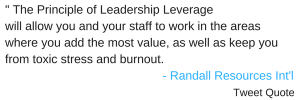Jack C. Randall, CIC, PCLA, PFMM
Kathleen M. Randall, CSP
© 2017 – All rights reserved.
STRESS. It’s a primary cause of physical ailments, mental burnout, and hairpin triggers. In our current culture of bigger—better—faster, managers and employees are stretched to the limit… expected to do more with less.

So what can you do to keep from burnout and best leverage the resources you already have?
Google the word “leverage” and you will find the definition “to use something to maximum advantage.” As leaders, we can leverage our talents and strengths to maximize our results. Yet there is a high likelihood that you are not leveraging talents and strengths to your greatest potential – both for your and your staff.
This critical lack of leadership leverage could be costing you big time… in undue stress and lost revenue from inefficiencies, missed opportunities, and lackluster sales. It could also be the reason you often feel drained and burned out. Wouldn’t it be great if you could be more efficient, less stressed, AND have more fun at the same time?
In, First Break All the Rules[1], co-authors Marcus Buckingham and Curt Coffman cite two flawed assumptions about people:
- Each person can learn to be competent in almost anything.
- Each person’s greatest room for improvement is in his or her areas of greatest weakness.”
In Now, Discover Your Strengths[2], Buckingham and Clifton polled 1.7 million employees with two simple questions:
- “What percentage do you think strongly agrees that they have an opportunity to do that they do best every day?”
- “What percentage truly feels that their strengths are in play?”
The results were startling. Only 20% of the global respondents felt that their strengths were in play every day. ONLY 20%! Even more interesting is their finding that, “the longer an employee stays with an organization and the higher he climbs the traditional career ladder, the less likely he is to strongly agree that he is playing to his strengths!”
Buckingham and Clifton[3] also discovered two assumptions that guide the world’s best managers:
- “Each person’s talents are enduring and unique.”
- “Each person’s greatest room for growth is in the areas of his or her greatest strength.”
At Randall Resources International, and from our experience in coaching executives from a variety of industries, we would heartily agree! Whether it regards your role in a management capacity or best practices to manage and grow your team, concentrate on discovering, understanding, and utilizing your strength and the strength of each individual on your team. That’s what we call the Principle of Leadership Leverage. The Principle of Leadership Leverage will allow you and your staff to work in the areas where you add the most value, as well as keep you from toxic stress and burnout.
As you lead and manage your department or staff, how might you apply the Principle of Leverage to lead, succeed, and be less stressed?
Just like the airline instructions to “put your own oxygen mask on first,” focus on your strengths first. Then focus on your team’s strengths. There are 5 keys to applying the Principle of Leadership Leverage:
1. Discover, understand, and grow YOUR individual Strengths!
- Utilize various objective and introspective tools available to discover your unique strengths:
- Key to discovery are introspective tools such as Marcus Buckingham’s “StrengthsFinder Profile.” Additional introspective tools such as a personality assessment (Myers-Briggs, DiSC, etc), an emotional intelligence assessment, a conflict mode assessment, etc. can also provide valuable insights.
- Gain an outside perspective of how others perceive your leadership through the use of a 360 multi-rater assessment. This unique tool can provide comparative insights as to how you view yourself versus how others view you. It also provides input on your individual strengths and challenges as you work across departments, supervise others, or support your boss.
2. Seek to apply your strengths where they are best utilized!
- Personal reflection: What functions/tasks of your job allow you to use your strengths? As Michael Hyatt says, “Know where you add value and where you don’t.”
- Personal reflection: What functions/tasks of your job actually drain your energy, frustrate you, or are non-productive? Is it a requirement that you perform these functions or can they be delegated?
- As an effective manager, use your strengths and time to grow your team, rather than simply working in the trenches and putting out fires.
- Personal reflection: Periodically, it may be helpful to step back and ask yourself the metaphorical question: Am I “on the right bus and am I in the right seat?” If not, is it time for you to initiate a change?
3. Get to know and understand the strengths and challenges of others on your team!
- Help and encourage them to identify and grow their individual strengths.
- Dialogue what type of functions/tasks actually motivate them.
- As opportunities arise, seek to funnel tasks to them in areas of their strength.
4. Delegate to others as appropriate to grow them and best utilize areas of their strengths.
- Take time to discuss with each team member as regards how you might assist them in using their strengths within the department and/or company. (This helps to leverage their strengths AND TEAM RESOURCES!)
- Might someone else be better suited or actually be motivated to take on the tasks that are not your strengths?
- Consider delegating tasks that actually motivate your employees based on their strengths. Delegating is not dumping. Delegating, when aligned with insight for personal and organizational growth, can actually grow your team and strengthen your organization’s next layer of leadership capabilities.
5. Invest in your team by training and coaching to bring information into application!
- People know when they are valued. Employees stay with a company longer when they know the management team is willing to grow them and give them the needed skills to be efficient and effective.
- Make room in your budget that includes a line-item for training and development.
- Growing people’s skills is an investment… not an expense. Investing in people is as important – or may be even more important – as investing in tangible line-item assets.
Whether it regards your role in a management capacity, or best practices to manage and grow your team, concentrate on discovering, utilizing, and leveraging your strengths and the strengths of each individual on your team.
Question: What will you do to maximize the Principle of Leadership Leverage?
Leave a comment below.
[1] Buckingham, Marcus and Curt Coffman. First Break All the Rules: What the World’s Greatest Managers Do Differently. New York, NY: Gallup Press. 1999.
[2] Buckingham, Marcus and Donald O. Clifton. Now, Discover Your Strengths. New York, NY: Gallup Press, 2001.
[3] Buckingham, Marcus and Donald O. Clifton. Now, Discover Your Strengths. New York, NY: Gallup Press, 2001.

